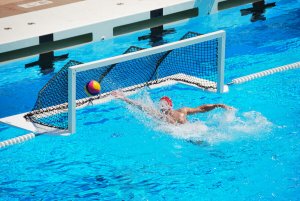The Basic Rules of Water Polo

Water polo is one of the most outstanding watersports in Europe, where several countries have won Olympic medals. But these days, this sport’s popularity has spread to other regions. As a result, there are more and more people showing an interest in learning the basic rules of water polo. Either to play or enjoy it as a spectator.
To make this easier, we’ve put together a list of the basic rules of water polo that guide the professional game, and we’ll also take a look at how things work in international competitions.
The aim of the game and how to play
Basically, water polo is a team sport where the main objective is to score the greatest number of goals by throwing the ball in the opposing team’s net.
Each match has four quarters which are eight minutes long with a two-minute break between each quarter. Each team has seven players. One of them is the goalkeeper, who wears a red cap to be easily identifiable from the other players.
Each team is permitted up to six substitute players, who can enter the pool at any time and there’s no limit to the number of substitutions.
There’s a specific area inside the pool for making changes and players must go to this area to enter or leave the ‘field of play’ during the match.
Whilst the game is underway, players must tread water and move without touching the pool floor. Touching the floor is expressly prohibited in the rules of water polo. As a result, water polo a highly complex sport that demands a lot of energy. This is why the playing periods are relatively short.

The seven basic rules of water polo
The pool
- In the men’s game, the pool is 30 x 25 meters (roughly 98 x 72 feet) in size, and, in the women’s game, the playing area is about 16 feet shorter.
- The pool consists of zones that determine the positions that the players can occupy and also help to award fouls, offsides, and penalties.
- The two-meter zone, for example, marks the correct location for offside. Likewise, the five-meter zone indicates where penalties are taken from after a foul.
The ball: rules of water polo
The ball is made of rubber and contains an air chamber. It also has a slightly rough surface to facilitate grip and handling during matches.
In men’s water polo, the ball must have a pressure of 13 to 14 psi, while in the female category the pressure is between 12 and 13 psi. It weighs between about 14 and 16 ounces.
Refereeing
For official matches in national, international, or Olympic competitions, the table officials and the referee will always be out of the water on the sides of the pool.
Goals and ball handling: rules of water polo
Players cannot use both hands to hold the ball, with the exception of the goalkeeper. They’re also not allowed to immerse the ball underwater whilst in play.
Players can score goals with any part of their body except a closed fist (only goalkeepers can use this to prevent a goal). Any infringement of these rules is a foul and will result in a free pass or penalty.
Fouls and expulsions
There are many different types of fouls in water polo and players can also be permanently sent off. In particular, any violent conduct between players, coaches, or anybody else will often result in a red card. The offender will then need to leave the pool area.

Penalties for coaches
Members of the coaching staff can also receive warnings about any inappropriate behavior and receive yellow cards. If this happens, they must remain seated throughout the match. However, in more serious cases, the referee may issue a red card and force the coach to leave the pool area.
Timeouts
In each game period, coaches may request a one-minute timeout with the option of requesting an extra minute.
To learn more about the rules of water polo, competitions, and other related events, check out the official site FINA, the international watersports federation, which covers a variety of water sports, including water polo.
All cited sources were thoroughly reviewed by our team to ensure their quality, reliability, currency, and validity. The bibliography of this article was considered reliable and of academic or scientific accuracy.
- Sitio oficial Federación Española de Natación. Extraído de: https://rfen.es/
- Federación Española de Natación. Reglamento de waterpolo 2019 – 2021. Extraído de: https://www.lautadaurpolo.es/joomla/images/PDFS/Reglamento_WP_2019-2021.pdf
This text is provided for informational purposes only and does not replace consultation with a professional. If in doubt, consult your specialist.








